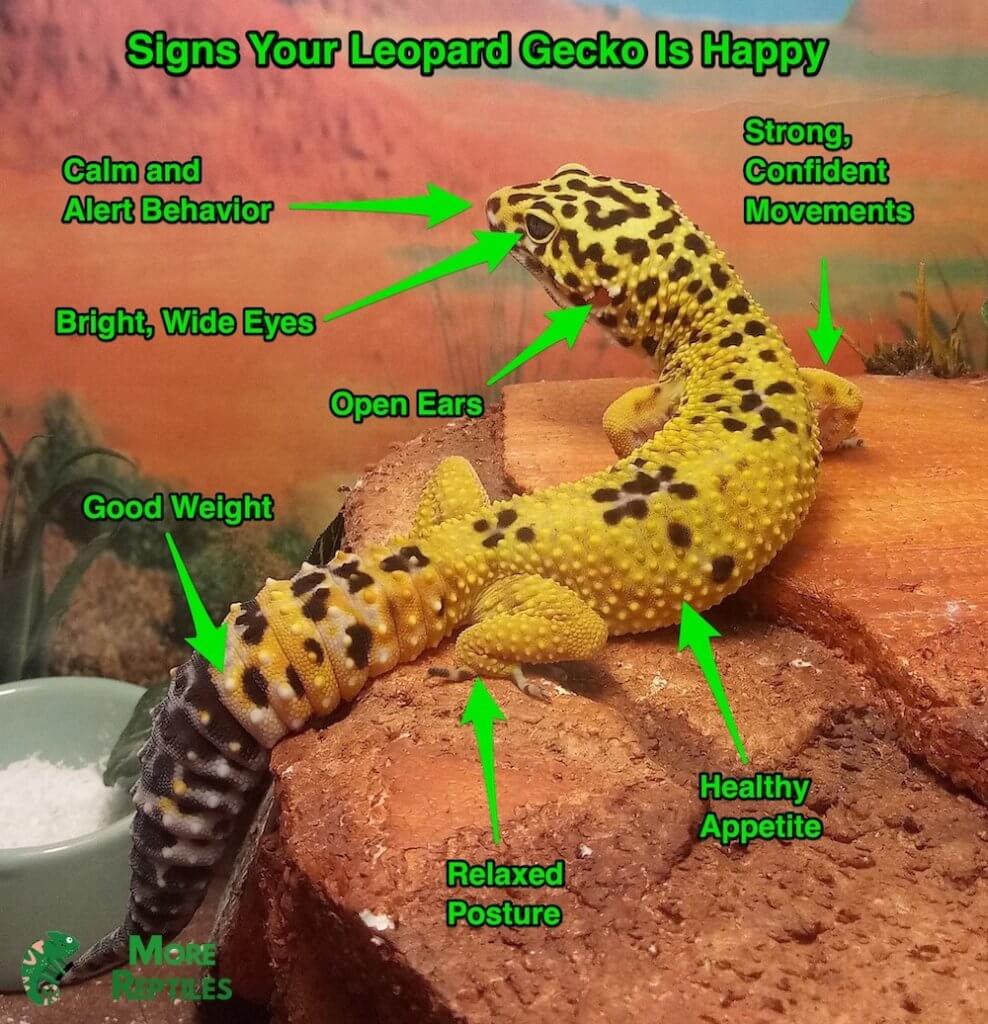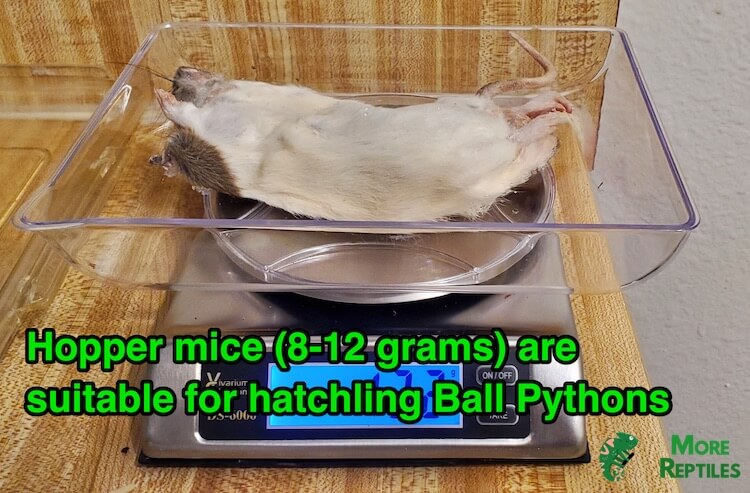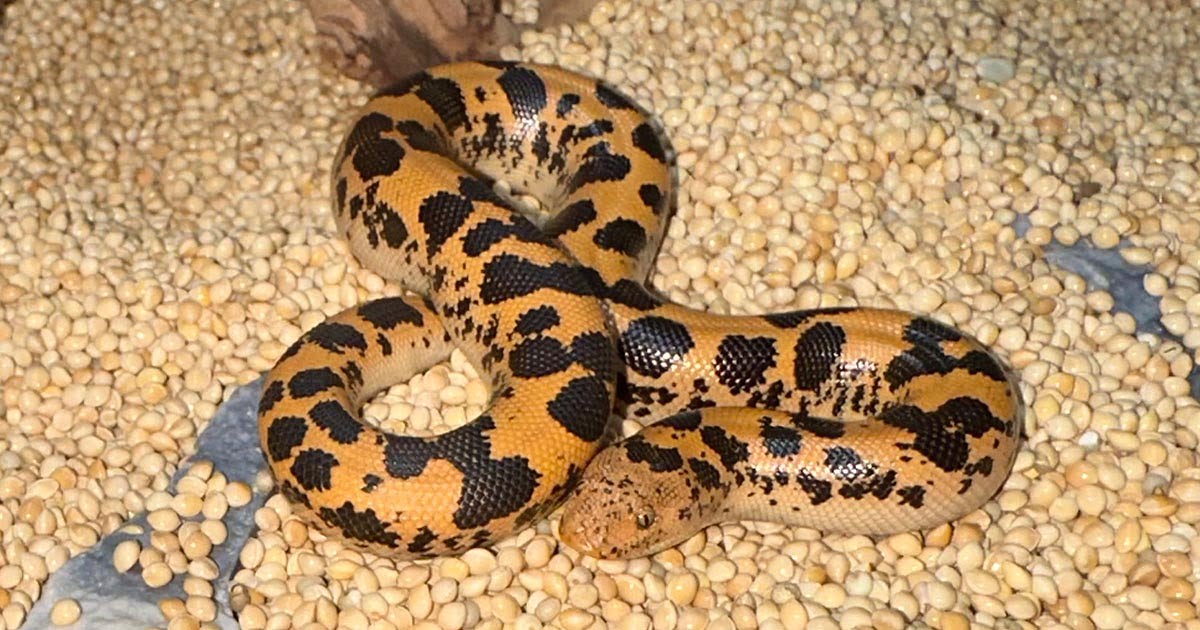Your gecko may have all its basic needs met, but how can you tell if a leopard gecko is happy?
Although they can’t express their happiness like a dog can, they do have several ways to communicate their level of comfort and contentment.
It took me several years to learn how to confidently read leopard gecko body language. By paying careful attention to movements, postures, and behaviors, I was surprised to learn just how expressive they really are!
In this article I’ll share the signs of a happy leopard gecko so you can determine your gecko’s happiness!
Key Takeaway
- Some signs of a happy gecko include curiosity, an interest in food, basking in the open, and reacting calmly when held or touched.
- Wide eyes, dilated ear openings, a relaxed tail, and smooth, confident movements all indicate good health and low stress.
- Although we don’t know if leopard geckos feel happiness in the same way that humans do, we can say that a “content” gecko is healthy, comfortable, well-fed and stimulated.
How To Tell If Your Leopard Gecko Is Happy

Over several years of keeping leopard geckos, I’ve discovered the number one indicator of happiness is a good appetite! Enthusiasm for food is a sign that your lizard is happy, content and healthy in its environment.
Happy leopard geckos are bright, alert, calm, and always ready to eat.
They should be curious about new decor and items in their tank, and will investigate by smelling and licking. They should also have a consistent sleeping schedule during the day and emerge after the lights are off to bask and explore.
1. Greedy Eater!
Leopard geckos have a reputation for being good eaters, sometimes even to the point of becoming greedy or overweight. From experience, happy geckos are always ready for a meal. In fact, one of the first signs of illness or stress is not eating.
If your little guy is interested in his food and eager for snacks, chances are that he is feeling pretty good!
I also recommend adding new foods every few weeks to keep him excited about mealtimes. Hornworms and black soldier fly larvae are two favorites of my geckos.
2. Basking in the Open
As cold-blooded animals, leopard geckos need warm temperatures to power their bodily functions. Pet geckos do this by basking under a heat lamp and/or above an under-tank heater.
Happy geckos that are comfortable in their enclosure will come out of their hides to bask in the open. Mine particularly loves to bask above her under-tank heater after eating. When basking, you might see your gecko flattened out with its feet splayed or tucked under. This basking position is a sure sign of a very relaxed lizard!
Stressed and sick lizards tend to be fearful and will not willingly wander/or bask into an unprotected area.
3. Approaching the Front of the Tank
Happy leopard geckos will learn to associate you with food and positive experiences. This, combined with their inquisitive nature, means that they will often come up to the front of their tank when they are hungry and see you.
If your leopard gecko approaches you confidently at feeding time, you can be sure they are feeling content!
Author Tip: Gentle handling and positive interactions are great ways to help your leopard gecko grow more comfortable with your presence.
4. Curiosity
I love leopard geckos for their inquisitive, outgoing personalities.
When they are comfortable with their enclosure and surroundings, I’ve found that they are not afraid to explore new decor and environments.
Relaxed, well-adjusted geckos will boldly investigate new additions to their enclosure (usually after dark) by approaching the furniture, smelling it, licking it and climbing on it. This behavior is a good sign of a happy gecko that feels safe.
5. Moving Smoothly
A leopard gecko that moves with confidence and coordination feels good, mentally and physically.
My youngest is an amazing climber that loves clambering on the branches in her enclosure!
It is best to watch your lizard after dark, when it has the most energy. Do they have shaky, uncoordinated steps or strong, smooth movements? These lizards should be strong, agile and climb rocks and boulders in their habitat.
6. Nighttime Activity
Activity at night is normal and indicative of happy leopard geckos.
These lizards are most active after the lights are off. In fact, they can actually be noisy and chirp as they climb around in their enclosure.
7. Friendly Demeanor
Leopard geckos are my favorite lizard species and considered one of the best pet reptiles for beginners, partly because of their friendliness.
These geckos should be are docile and gentle.
Stressed individuals are much more likely to show aggressive behaviors like biting. The only time I’ve ever had a leopard gecko bite me was when he was excited during mealtime and mistook my finger for a cricket.
8. Regular Sleep Schedule
A leopard gecko that sticks to its regular, 24-hour cycle is most likely satisfied.
Leopard geckos are nocturnal, so they sleep during the day and come out at night. Their usual nighttime activity should be balanced by rest during the day. Just like us, they need several hours of sleep to feel good – about 12 hours each day is considered normal.
Hyperactivity can be a sign of boredom or anxiety in leopard geckos.
I usually go all day without seeing my geckos out (and in fact, they are often quite grumpy if I wake them up while the lights are on), but as soon as it gets dark they are out and about. I have observed that mine have a remarkably consistent schedule, even down to the hour that they’ll start to become active.
9. Relaxed Tail
Some of the subtler, as well as most important, signs of happiness in leopard geckos can be picked up from their body language. Happy lizards will have fairly relaxed, but alert body language. A relaxed tail, straight spine, and upright head are all happy, normal postures.
Ears are another clue of a gecko’s mood!
When relaxed and happy, their ear openings are wide. When stressed, they will constrict.
My best advice for learning leopard gecko body language is to simply watch them! Go to pet stores and watch their geckos, then compare their expressions and behaviors to your own lizard at home.
You can partly judge how well a gecko is feeling by how it reacts to your touch and presence. Happy individuals will investigate you by licking and may even climb onto your fingers.
Enrichment Ideas
Adding enrichment to your gecko’s enclosure is a great way to improve their quality of life, let them express natural behaviors, and keep them happy.
In my experience, leopard geckos with more enrichment are more active, relaxed, and inquisitive!
Enrichment and mental stimulation is essential for the well-being and happiness of these popular pet lizards.
I like to break enrichment into three parts:
- Diet
- Habitat
- Sensory
Diet
Mix up your gecko’s diet every couple of weeks by adding a new type of prey. I generally feed crickets as a staple, but also offer dubia cockroaches, hornworms, or black soldier fly larvae a few times each month on a rotating basis.
Rotating prey not only keeps your gecko interested in food, but makes sure they get all of their necessary nutrients.
Dr. Jerry Ayaebi, our veterinary consultant, says “do not feed your gecko wild insects, ensure to get your insects from the pet shop. Wild insects could carry parasites that are harmful to your gecko. Also, avoid feeding glowing insects (like fireflies) as they can harm and in some cases kill your pet.”
Habitat
Habitat enrichment means giving your gecko new places in its tank to explore and interact with.
My leopard gecko’s enclosure features a 5 inch x 6 inch “dig box” filled with coconut coir and vermiculite.

Though it took several days for her to use the dig box for the first time, I now spot her digging several times a week! Other great habitat enrichment ideas include:
- Multi-story hide
- Natural branches
- Live or fake plants
- Rocks
Sensory
Sensory enrichment involves adding new smells or textures to your gecko’s day-to-day routine, like a soft towel, a piece of slate, or a crinkly toy. Handling also counts as sensory enrichment, as long as you keep it a positive and stress-free experience.
I enjoy the look of a more natural terrarium, so I prefer items like live plants, wooden hides, and rocks.
However, enrichment can really be as simple as adding some cardboard paper towel tubes for your lizard to climb through provides stimulation and enrichment.



